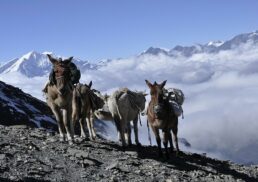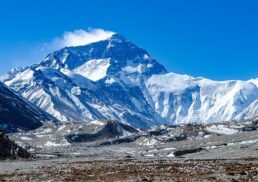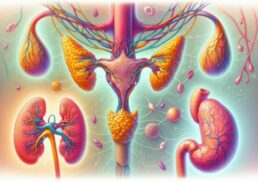Planning a climb Kilimanjaro tour? Here’s what you need to know: routes, gear, preparation, and what to expect on your adventure. Let’s get started!
Table of Contents
Key Takeaways
Climbing Mount Kilimanjaro offers a transformative adventure through diverse ecosystems, with a high success rate of reaching Uhuru Peak for determined climbers.
Choosing the right route is crucial; options like Machame and Lemosho provide stunning views and better acclimatization, while routes like Marangu offer quicker, more accessible climbs.
Emphasizing ethical trekking practices and proper preparation, including having expert guides, the right gear, and understanding altitude sickness, is essential for a safe and enjoyable climb.
Experience the Ultimate Kilimanjaro Climb
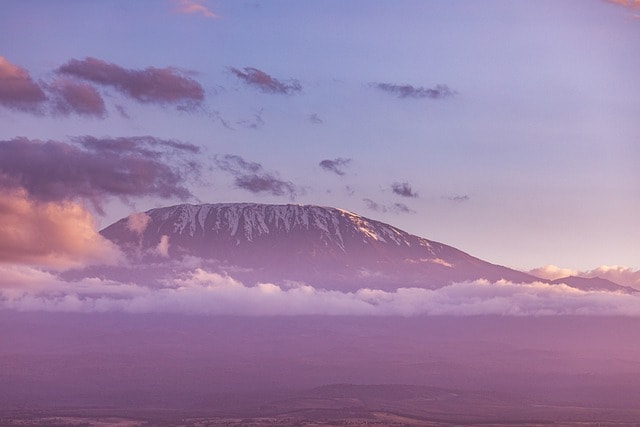
Standing at 19,341 feet, Mount Kilimanjaro is the highest mountain in Africa, offering climbers the chance to reach the ‘Roof of Africa’ and create lifelong memories. The allure of this adventure is not just in the physical challenge but in the transformative experience it provides. Imagine trekking through diverse ecosystems, from lush rainforests to alpine deserts, all within a span of a few days. The journey is as rewarding as the destination, with every step bringing new vistas and encounters.
Climbing Kilimanjaro generally takes eight to ten days, with about six days dedicated to hiking. The trek can be challenging due to the altitude, terrain, and length, requiring a good level of physical fitness and proper guidance. However, the experience is inclusive, with climbers of all ages, from children over ten to older generations in their 60s and 70s, enjoying the trek. Safety, thrill, and meaningful engagement are the hallmarks of a successful climb.
A Kilimanjaro expedition emphasizes the journey as much as reaching the summit. A success rate of 98% makes reaching Uhuru Peak achievable for those who are prepared and determined to conquer Kilimanjaro. The sense of accomplishment and the memories created are priceless, making every step worth the effort during kilimanjaro treks on a kilimanjaro trip.
As you stand at the summit, surrounded by unparalleled panoramas, you’ll understand why climbing Kilimanjaro is a bucket-list adventure for many.
Choosing the Right Kilimanjaro Route
Selecting the appropriate route for your Kilimanjaro climb is key to a successful and enjoyable journey. Each of the main Kilimanjaro routes—the Machame, Marangu, Lemosho, and Northern Circuit—offers unique challenges and rewards.
The best route for you will depend on your preferences, fitness level, and the kind of experience you’re looking for. Let’s explore these routes in detail.
Machame Route
The Machame Route, also known as the Whiskey Route, is one of the most popular paths for climbing Kilimanjaro, favored for its high success rate and scenic beauty. As you ascend, you’ll pass through diverse landscapes, from lush rainforests to the stunning Shira Plateau. This route offers a gradual climb, which is beneficial for altitude acclimatization, increasing your chances of a successful summit.
However, the popularity of the Machame Route means it can be quite busy, especially during the peak climbing seasons. If you’re looking for a more solitary experience, you might want to consider one of the less crowded routes.
Despite this, the breathtaking views and the rewarding journey make the Machame Route a favorite among many trekkers.
Marangu Route
The Marangu Route, often called the “Coca-Cola Route,” is unique because it offers hut accommodations, providing a bit more comfort compared to camping. This route is typically chosen by budget-conscious trekkers due to its quicker ascent and lower costs. However, the shorter duration means there are fewer opportunities for acclimatization, which can increase the risk of altitude sickness.
Despite its challenges, the Marangu Route is a good option for those who prefer a more straightforward climb with the convenience of staying in huts. It’s also one of the easiest paths up the mountain, making it accessible for less experienced climbers.
Lemosho Route
The Lemosho Route is a favorite for those seeking beautiful views and a less crowded experience. Starting on the western side of Kilimanjaro, this route offers a more secluded hiking experience. The gradual ascent and spectacular scenery make it a popular choice, contributing to its high summit success rate.
The Lemosho Route provides plenty of opportunities for acclimatization, which is crucial for a successful climb. If you’re looking for a route that combines stunning landscapes with a higher chance of reaching the summit, Lemosho is an excellent option.
Northern Circuit Route
The Northern Circuit Route is renowned for its optimal acclimatization and less crowded paths. This route allows for a gradual ascent, which enhances the body’s ability to adapt to higher altitudes. Trekkers on this route enjoy a more serene and peaceful experience, away from the busier southern routes.
The Northern Circuit takes a longer path around the mountain, providing some of the best views and a higher chance of summit success. If you have the time and prefer a quieter trek, this route offers a comprehensive and rewarding Kilimanjaro experience.
Ethical and Responsible Trekking Practices
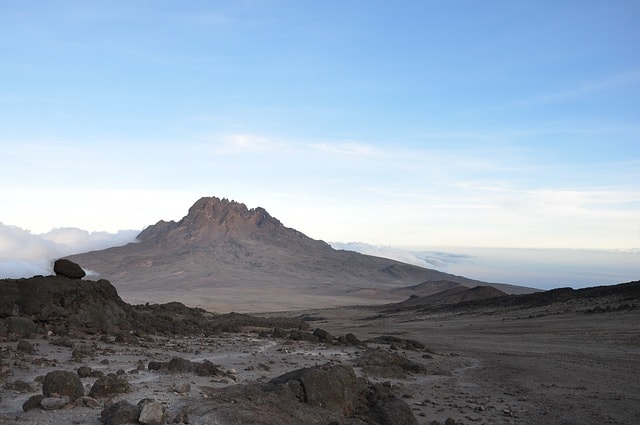
Ethical and responsible trekking practices are essential for preserving Mount Kilimanjaro’s unique environment and supporting the local community. Climbers are required to be accompanied by licensed guides and porters, which not only ensures safety but also supports the local economy. The Kilimanjaro Porters Assistance Project (KPAP) plays a crucial role in monitoring standards for porter wages and medical care, ensuring fair treatment.
Environmental conservation is also a key focus. The Kilimanjaro National Park has banned single-use plastics to combat littering and waste management issues. Trekkers are encouraged to adopt a ‘leave no trace’ principle, ensuring proper waste disposal and minimizing their environmental impact.
Support groups on Kilimanjaro are responsible for disposing of climbers’ litter appropriately, and many trekking groups now use private latrines to manage human waste effectively. Opting for ethical tourism companies and supporting local conservation efforts helps preserve this natural wonder for future generations.
Expert Guides and Support Team
Having expert guides and a strong support team is crucial for a successful Kilimanjaro climb. Guides often undergo extensive medical training as High Altitude First Responders, enhancing climber safety. They focus on individual climber needs, offering customized support and motivation throughout the ascent.
Regular medical checks are performed to monitor climbers’ conditions and address potential issues early. Local guides, with their intimate knowledge of Kilimanjaro’s terrain and conditions, play a vital role in navigating the challenges of the ascent. Their expertise and experience are key to ensuring a safe and successful journey to the summit.
Essential Gear for a Successful Climb
Equipping yourself with the right gear is essential for a successful Kilimanjaro climb. Moisture-wicking base layers are important for managing sweat and preventing chilling in changing weather conditions. A hard shell outer jacket is necessary to protect against rain and wind, while UV-protective sunglasses are critical due to the increased sun intensity at high altitudes.
A well-fitted, mid-weight trekking boot with ankle support is crucial for navigating the challenging terrain. A 4-season sleeping bag rated for cold temperatures ensures comfort during nighttime at higher altitudes. Additionally, trekking poles can help reduce joint stress and improve balance on steep descents. Proper gear not only enhances your comfort but also significantly increases your chances of summit success.
Best Time to Climb Mount Kilimanjaro
The best time to climb Mount Kilimanjaro is during the dry seasons, from December to mid-March and late June to October. These periods offer mostly dry conditions with clear weather, making the climb more manageable. January and February are particularly good months to climb due to their favorable weather.
Climbing during the rainy season, especially from April to early May, is not advisable due to the dangerous trail conditions. July and August are the busiest months, coinciding with summer vacations in the US and Europe. Choosing the right time to climb can greatly enhance your experience and increase your chances of a successful summit.
Learn more, checkout The Best Time to Climb Kilimanjaro.
Preparing for Altitude Sickness
Preparing for altitude sickness is crucial for a successful Kilimanjaro climb. Gradual ascent is key, ideally over eight to nine days, to allow the body to adjust to the decreasing oxygen levels. Routes like Machame and Lemosho, which offer gradual climbs, are beneficial for acclimatization.
Hydration is also essential; climbers are advised to drink four to five liters of water daily to mitigate symptoms of altitude sickness. Guides set a pace that balances speed to avoid altitude sickness while ensuring the climb does not become excessively long.
The shared knowledge and experience of guides can greatly improve acclimatization and overall climb success.
Joining a Kilimanjaro Group Tour
Joining a Kilimanjaro group tour offers numerous benefits that enhance the overall climbing experience. Participating in a group tour fosters motivation and camaraderie among climbers, creating lasting memories and friendships with like-minded adventurers.
Group tours can also significantly reduce the overall costs of climbing Kilimanjaro compared to private expeditions. With multiple guides and support staff, safety is enhanced, and better assistance is provided during the climb. Joining a group tour is a great way to share the adventure and make the climb more enjoyable and affordable through kilimanjaro tours.
What to Expect on Summit Day
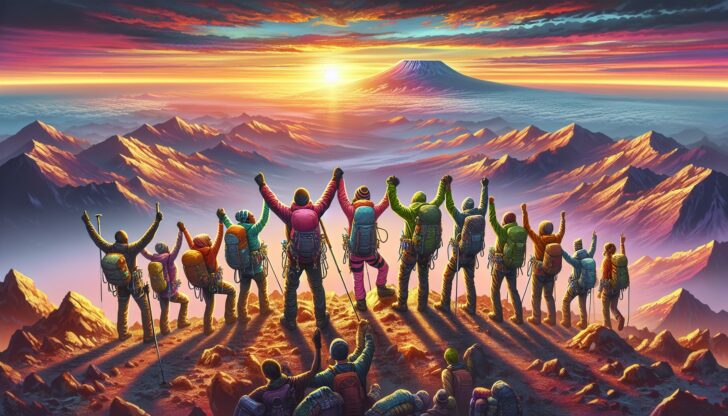
Summit day on Kilimanjaro is both the most challenging and rewarding part of the climb. The trek begins around midnight after a brief rest at Barafu Camp, where climbers prepare their daypacks and take a hot drink. The early start allows climbers to reach the summit by sunrise, providing breathtaking views and a sense of accomplishment.
Acute mountain sickness (AMS) is a common issue, affecting many climbers when they ascend above 3,000 meters. After reaching the summit, the descent requires careful management of pace and use of poles for balance, especially for those with knee issues.
Despite the challenges, reaching the summit of Kilimanjaro is a momentous achievement that makes all the effort worthwhile, especially when considering climbing mount kilimanjaro.
Exploring Beyond Kilimanjaro
Exploring Tanzania and East Africa offers a variety of activities and destinations that complement a Kilimanjaro adventure. The Zanzibar Archipelago, with its mix of African and Arabian influences, beautiful beaches, and rich history, is a significant cultural and historical destination. Ngorongoro Crater offers breathtaking views and is home to diverse wildlife, including endangered black rhinos.
Lake Natron is a premier birdwatching site, particularly for its flourishing flamingo populations. Chimpanzee tracking in Gombe and Mahale Mountains National Parks provides a unique opportunity to observe these primates in their natural habitat.
Exploring beyond Kilimanjaro allows you to experience the rich diversity of Tanzania and East Africa.
Summary
Climbing Kilimanjaro is a journey of a lifetime, combining physical challenge, stunning landscapes, and a deep sense of achievement. By choosing the right route, preparing adequately, and following ethical trekking practices, you’ll not only enjoy a successful climb but also contribute to preserving this magnificent mountain for future generations. The importance of expert guides and the right gear cannot be overstated, as they play crucial roles in ensuring your safety and comfort throughout the trek.
Whether you’re exploring the diverse ecosystems on Kilimanjaro, preparing for the challenges of altitude sickness, or joining a group tour for camaraderie and support, every aspect of this adventure is designed to create lasting memories. As you stand on the summit, looking out over the vast landscapes of Tanzania, you’ll understand why climbing Kilimanjaro is considered one of the world’s most iconic adventures. So, gear up, choose your route, and get ready to conquer Kilimanjaro!
Frequently Asked Questions
What is the best time to climb Mount Kilimanjaro?
The best time to climb Mount Kilimanjaro is during the dry seasons, specifically from December to mid-March and late June to October, ensuring the most favorable weather conditions for your adventure. Get ready to reach new heights!
Which Kilimanjaro route is best for beginners?
The Marangu Route is the best choice for beginners, offering a smoother path and comfortable hut accommodations that make the climb more enjoyable. This route will set you up for a successful and memorable adventure!
How do I prepare for altitude sickness when climbing Kilimanjaro?
To effectively prepare for altitude sickness on Kilimanjaro, prioritize gradual ascent, stay well-hydrated, and select routes like Machame or Lemosho that provide ample acclimatization. Your success depends on smart planning, so set yourself up for an amazing adventure!
What essential gear do I need for a Kilimanjaro climb?
For a successful Kilimanjaro climb, make sure to pack moisture-wicking base layers, a hard shell jacket, UV-protective sunglasses, sturdy trekking boots, a 4-season sleeping bag, and trekking poles. Gear up right, and you’ll be ready to conquer that summit!
Why should I join a Kilimanjaro group tour?
Joining a Kilimanjaro group tour not only lowers your costs and increases safety, but it also allows you to build lasting friendships with fellow adventurers. Embrace the journey together and make unforgettable memories!


